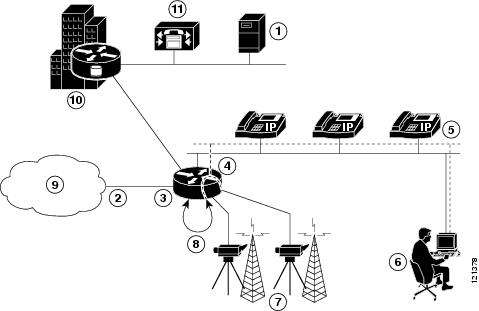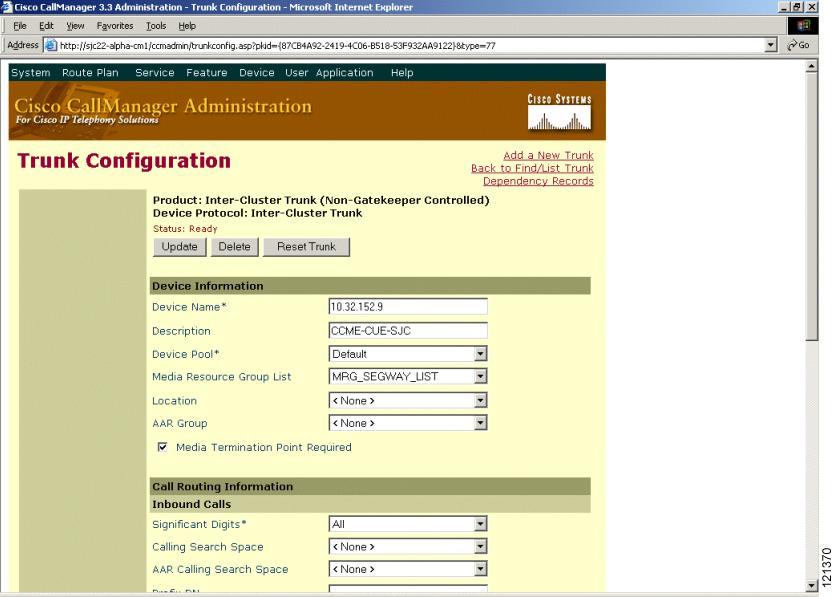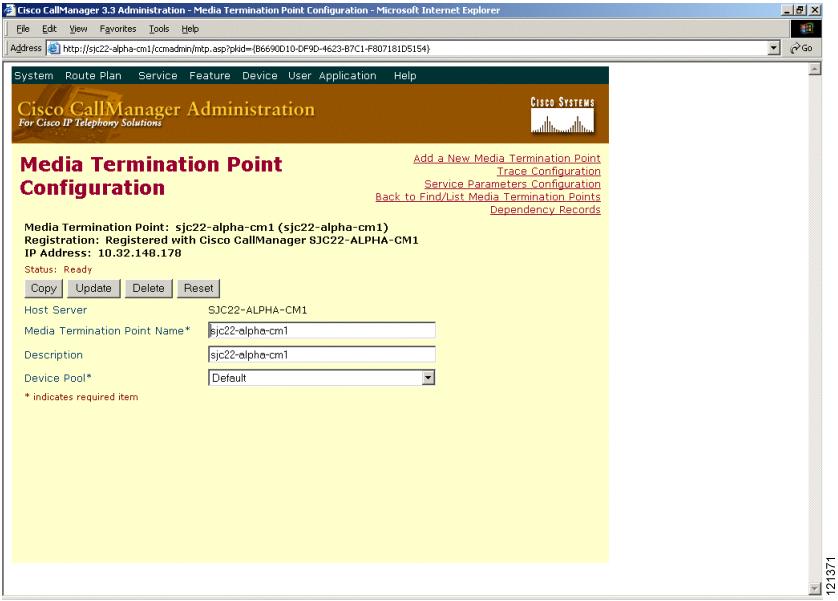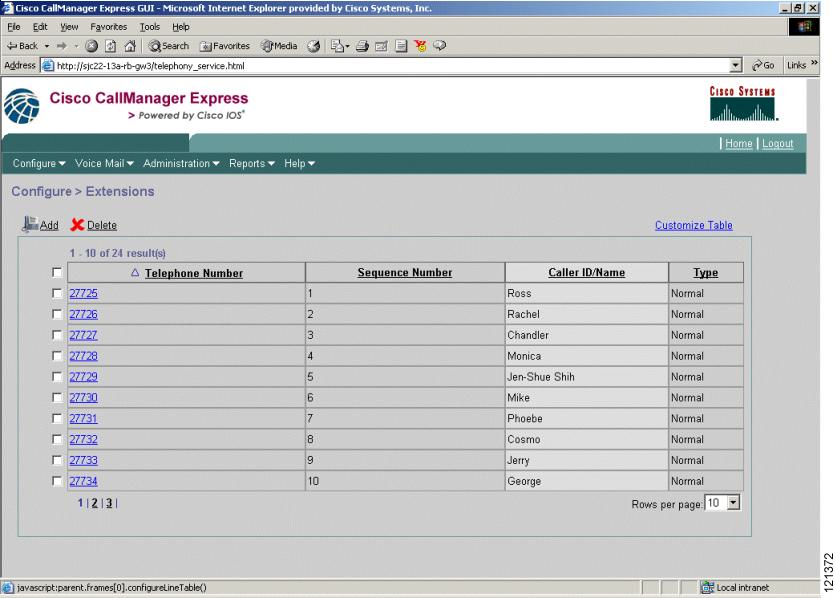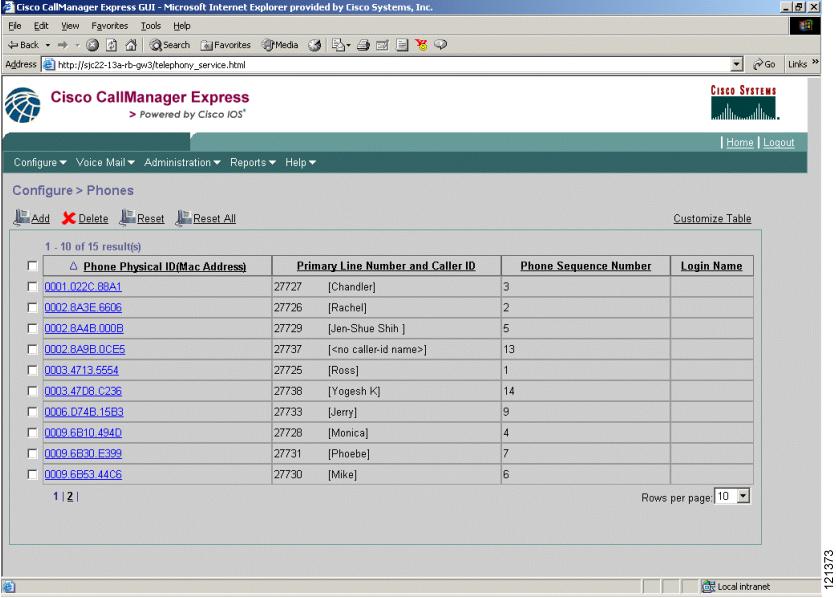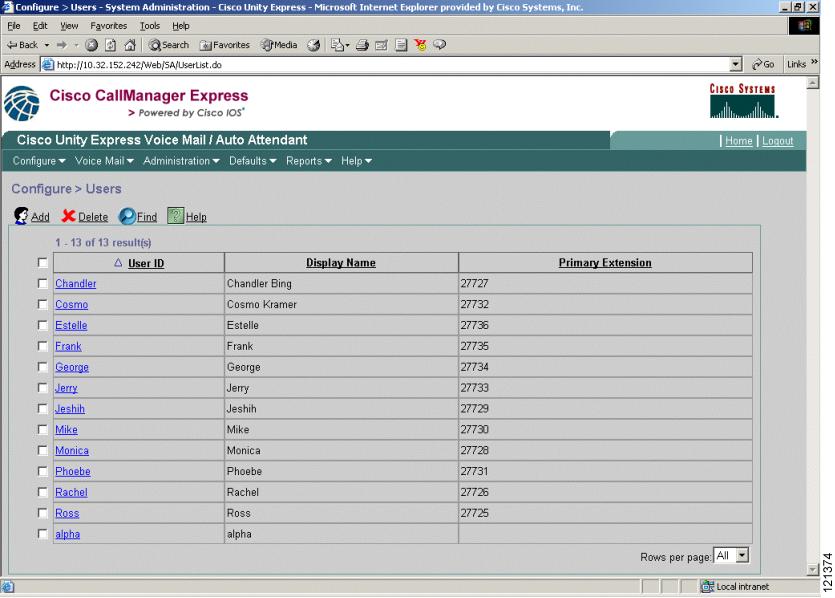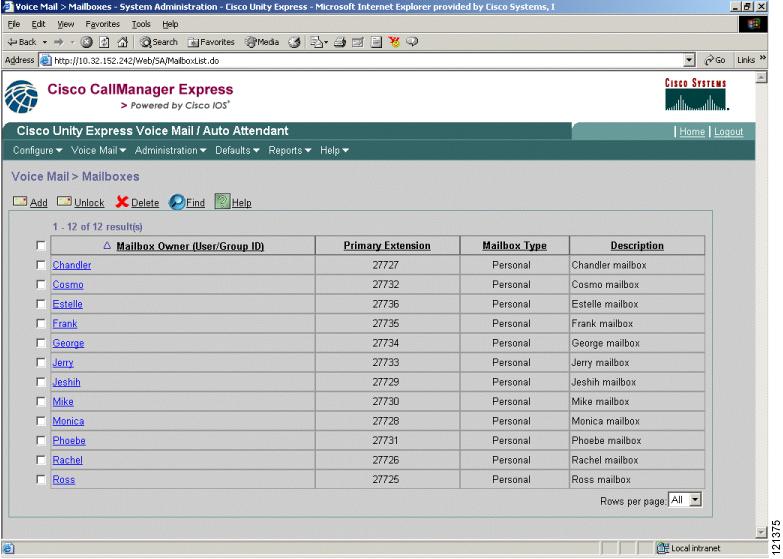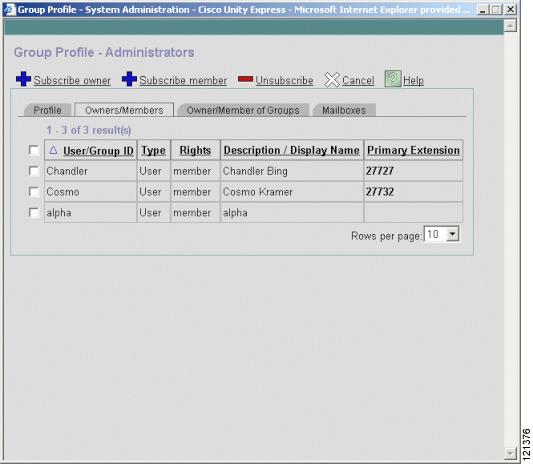

-
Cisco 1800 Series Software Configuration
-
Cisco Integrated Services Routers: Preface
-
Cisco 1800 Series Integrated Services Routers (Modular): Overview
-
Configuration: Basic Software Configuration Using the Setup Facility
-
Configuration: Basic Software Configuration Using the Cisco IOS Command-Line Interface
-
Configuration Example: Secured Branch Router
-
Configuration Example: IP Communication Solution for Group Applications
-
Configuration Example: Easy VPN
-
Configuration Example: Hoot and Holler over V3PN
-
Finding Feature Documentation
-
Troubleshooting and Maintenance: Changing the Configuration Register Settings
-
Troubleshooting and Maintenance: Using the ROM Monitor
-
Troubleshooting and Maintenance: Using CompactFlash Memory Cards
-
Troubleshooting and Maintenance: Upgrading the System Image
-
Troubleshooting Links
-
Table Of Contents
IP Communication Solution for Group Applications Configuration Example
Verification Screens: Examples
Cisco CallManager Screen Examples
Cisco Unity Express Screen Examples
Troubleshooting Reference Documents and Commands
IP Communication Solution for Group Applications Configuration Example
Contents
Introduction
This document provides a configuration example in which:
•
A small branch office uses both analog and IP phones. The small branch office implementation addressed in this document requires IP Telephony services and may also use other full-service branch (FSB) features of Cisco access routers. These features include Cisco Content Engines (CEs), Voice over IP (VoIP) services and integration with back-end VoIP call control devices. The small branch office requires a robust and integrated voice-mail solution. The integrated services routers also support various options for WAN uplink and integrated LAN switching modules.
•
Land Mobile Radio (LMR) is used by an enterprise for several reasons which include loss prevention (premise safety and security) and Push-to-Talk (PTT) communication for mobile workers within range of the radio system. LMR base stations can be connected to an E&M port for integration with an IP network and can be accessed via VoIP. The LMR feature also allows connecting walkie-talkies to the radios using multicast.
•
Multicast is dial-plan enabled so that IP phones and public switched telephone network (PSTN) phones can dial in to the LMR by using E.164 numbers. Traditionally, the E&M ports were used to connect to PSTN or Hoot-and-Holler networks. The E&M ports connected to the LMR can be multicast-to-VoIP enabled. This configuration permits desktop clients and IP-Phone clients on the LAN that are using XML services to directly connect to the radio via the multicast features on Cisco IOS. The LMR can be integrated with the E&M port on the gateway; the commands on the gateway support this router-to-radio adaptation.
•
This document provides a workaround method that bridges the multicast VoIP to unicast VoIP using a physical T1 loopback. This is not an essential configuration. It is documented to demonstrate how you can integrate multicast VoIP audio into standards-based VoIP call-control schemes such as Skinny, H.323, or SIP. IP-to-IP gateway is the preferred and recommended option to use for bridging between standards-based VoIP protocols. The VoIP-to-multicast bridge using a physical loopback can also be used for local multi-party conferencing via Cisco CallManager Express (Cisco CME) phones or PSTN phones.
•
Onboard DSPs are used for the voice modules on the WAN interface car (WIC) slots
•
Cisco CallManager seamlessly connects to Cisco CME over an H.323 trunk defined on the Cisco CallManager [Release 3.3 (3) or later].
•
Cisco CME (Release 3.2) manages the local phone network. Cisco CME and Cisco Unity Express enable users to use a gateway as though it were a PBX coupled to a voice-mail system.
•
Cisco Unity Express (with Cisco Service Engine 1.1) on the NM-CUE provides voice-mail and auto-attendant services.
•
Cisco CME seamlessly integrates with the Cisco CallManager at the headquarters site and supports all supplementary services.
•
Content Engine (CE) modules support web caching, video-on-demand and live-splitting applications.
•
Cisco Access Control Network Server (ACNS) on CE (ce2636-sw-5.1.3) saves WAN bandwidth by web-caching and splitting streaming video over unicast and multicast.
Prerequisites
Prerequisites included in this section:
Requirements
There are no specific requirements for this document.
Components Used
The information in this document is based on the following software and Cisco 3845 router hardware and software:
•
16 FastEthernet interfaces (NM-ESW-16)
•
1 serial interface
•
3 terminal lines
•
2 channelized T1/PRI ports
•
4 voice FXS interfaces (VIC-4FXS-DID)
•
2 voice E&M interfaces (VIC2-2E&M)
•
1 Cisco service engine (NM-CUE)
•
1 Cisco Content Engine (NM-CE-BP)
•
A VIC2-4FS in slot 0
•
A VIC2-2FXS in slot 1
•
An HWICD-9ESW with inline power card in slots 2-3 (double-wide)
•
Cisco CallManager Release 3.3(3)
•
Cisco IOS Release 12.3(11)T or later
•
Enterprise Services feature set
The information in this document reflects use of devices in a specific lab environment. All devices used in this configuration example started with a cleared (default) configuration. If you are working with a live network, ensure that you understand the potential effects of any command before you use it. The configuration example presented in this document depicts a combination of features on a single branch office router. Users of this document should review the documents listed under the"Related Information" section.
Related Products
This configuration can also be used with any Cisco 2800 and Cisco 3800 series routers.
Conventions
For more information on document conventions, see the Cisco Technical Tips Conventions.
Configure
In this section, you are presented with the information to configure the features described in this document.
Note
To find additional information on the commands used in this document, use the Cisco IOS Command Lookup tool. You must have an account on Cisco.com. If you do not have an account or have forgotten your username or password, click Cancel at the login dialog box and follow the instructions that appear.
Configuration Tips
•
The gigabit port on the router does not provide inline power.
•
Routing should be enabled and assumed to be configured.
•
The external flash card on the integrated services routers holds the router image, VLAN database, graphical user interface (GUI) files for Cisco CME and Cisco Unity Express. It should not be removed during the normal operation of the router.
•
The LMR integration to the router might require radio frequency (RF)/radio skills (typically a non-IP and proprietary implementation). The radio-to-router physical cable might not be available off-the-shelf.
Network Diagram
This document uses the network setup shown in the following diagram.
Configurations
This example presents configuration for the Cisco 3845 router.
Cisco 3845 Router
3845-gw#show running-configBuilding configuration...Current configuration : 17622 bytes!!---Last configuration change at 23:07:46 PDT Wed Jul 7 2004 by cisco!version 12.3service timestamps debug datetime msec localtime show-timezoneservice timestamps log datetime msec localtime show-timezoneservice password-encryptionservice internal!hostname 3845-gw!boot-start-markerboot-end-marker!logging buffered 4096 informationalenable secret 5 $1$3do1$SDp9TOK4YaZ7XguJYD2MD1!!---Local Database of username and passwords for Web server and local!---authentication!username cisco password 7 1511021F0725!clock timezone PST -8clock summer-time PDT recurringno network-clock-participate slot 1no network-clock-participate slot 2no network-clock-participate slot 3no network-clock-participate slot 4no network-clock-participate wic 0no network-clock-participate wic 1network-clock-participate wic 2no network-clock-participate wic 3no network-clock-participate aim 0no network-clock-participate aim 1aaa new-model!!aaa group server tacacs+ adminserver 192.x or 10.xserver 192.x or 10.x!aaa group server radius vpnserver 192.x or 10.x auth-port 1645 acct-port 1646!!---AAA configuration used for local authentication!aaa authentication login admin group tacacs+ enableaaa authentication login remote group vpnaaa authentication login NOTACACS lineaaa authentication login LOCAL localaaa authentication login WEB noneaaa authentication ppp LOCAL localaaa authentication dot1x default group vpnaaa authorization consoleaaa authorization exec default localaaa authorization network groupauthor localaaa session-id commonip subnet-zerono ip source-route!ip cef!!!---Configure a DHCP address pool for each IP phone:ip dhcp excluded-address 192.168.10.1 192.168.10.99!ip dhcp pool NONATnetwork 10.1.153.0 255.255.255.248default-router 10.1.153.1dns-server 10.1.162.183 10.1.156.120option 150 ip 10.1.152.9domain-name cisco.com!ip dhcp pool NATnetwork 192.168.10.0 255.255.255.0default-router 192.168.10.1dns-server 10.1.162.183 1010.1.156.120option 150 ip 10.1.152.9domain-name cisco.com!ip domain name cisco.comip name-server 10.1.162.183ip name-server 10.1.156.120ip multicast-routingip sap cache-timeout 30ip ssh time-out 30ip ssh version 1ip ids po max-events 100no ip rcmd domain-lookupip rcmd rcp-enableip rcmd rsh-enable!voice-card 0no dspfarm!!!!---Configuration to enable "H.323 to H.323" and "H.323 to SIP" calls between Cisco!---CallManager-Cisco CME-Cisco Unity Express. The "allow connections h323 to h323" &!---"allow-connections h323 to sip" enable an easy configuration on gateway without the!---need for loopback-dn for incoming calls from Cisco CallManager or for call flow from!---Cisco CallManager to SIP for Voice Mail.!voice service voipallow-connections h323 to h323allow-connections h323 to sipno supplementary-service h450.2no supplementary-service h450.3supplementary-service h450.12 advertise-onlyh323!!!!---Configuration to support LMR(Land Mobile Radio) integration through E&M port on the!---router (similar to Hoot and Holler configuration)!voice class permanent 1signal timing oos restart 50000signal timing oos timeout disabledsignal keepalive disabledsignal sequence oos no-action!!!---Two T1 ports connected back-to-back to bridge VoIP to multicast audio bridging. This!---is required to enable dialing into multicast. Connecting the TDM T1 port back-to-back!---offers the possibility of using E.164 number as a conference ID, or for using the!---multicast stream for application such as Hoot and Holler.!---!---Cisco CME offers 3-party conference calling and is the recommended method for a!---small branch office, the following T1 loopback cable is not required for configuring!---the conferencing features.!---!---Cisco IOS supports audio mixing of loudest three streams. The TDM back to!---back connection enables the bridging of 23 channels of VoIP to one or!---more multicast connections (one side with multicast configuration and the!---other side with VoIP configuration)!---This method provides a way to connect the standards-based VoIP call control to!---the multicast audio streams that do not have any associated call control.!controller T1 0/2/0framing esflinecode b8zsds0-group 1 timeslots 1 type e&m-immediate-startds0-group 2 timeslots 2 type e&m-immediate-startds0-group 3 timeslots 3 type e&m-immediate-startds0-group 4 timeslots 4 type e&m-immediate-startds0-group 5 timeslots 5 type e&m-immediate-startds0-group 6 timeslots 6 type e&m-immediate-start!controller T1 0/2/1framing esfclock source internallinecode b8zsds0-group 1 timeslots 1 type e&m-immediate-startds0-group 2 timeslots 2 type e&m-immediate-startds0-group 3 timeslots 3 type e&m-immediate-startds0-group 4 timeslots 4 type e&m-immediate-startds0-group 5 timeslots 5 type e&m-immediate-startds0-group 6 timeslots 6 type e&m-immediate-start!no crypto isakmp enable!!!---Loopback0 used to bind H323 to the Loopback0 interface. RTP Packets!---originate/terminate on the router using this IP address.!interface Loopback0ip address 10.1.152.9 255.255.255.255h323-gateway voip interfaceh323-gateway voip bind srcaddr 10.1.152.9!interface Loopback2ip address 10.1.152.241 255.255.255.252ip ospf network point-to-point!interface Loopback3ip address 10.1.152.249 255.255.255.252ip virtual-reassemblyip ospf network point-to-point!!---Configuration to enable Hoot and Holler using multicast on router. The multicast!---streaming of packets from the local router uses the VIF interface to derive the local!---ip address and the port of the packets. This can be verified by the show command "show!---voip rtp connection"!interface Vif1ip address 10.1.153.41 255.255.255.252ip pim sparse-dense-mode!!!---WAN uplink!interface Serial0/0/0ip address 10.1.152.30 255.255.255.252ip pim sparse-dense-modeip nat outsideip virtual-reassemblyno fair-queue!!--- Content Engine connected as a Network Module.!interface Content-Engine1/0ip unnumbered Loopback3ip pim sparse-dense-modeservice-module ip address 10.1.152.250 255.255.255.252service-module ip default-gateway 10.1.152.249!!interface FastEthernet3/0switchport access vlan 110switchport trunk native vlan 100switchport mode trunkswitchport voice vlan 110no ip address!interface FastEthernet3/1switchport access vlan 100switchport trunk native vlan 100switchport mode trunkswitchport voice vlan 110no ip address!interface FastEthernet3/2switchport access vlan 100switchport trunk native vlan 100switchport mode trunkswitchport voice vlan 110no ip address!interface FastEthernet3/3switchport access vlan 100switchport trunk native vlan 100switchport mode trunkswitchport voice vlan 110no ip address!!!---Cisco Unity Express used for local voice-mail storage!interface Service-Engine4/0ip unnumbered Loopback2service-module ip address 10.1.152.242 255.255.255.252service-module ip default-gateway 10.1.152.241!!--- Data VLAN, used for the desktops at the branch!interface Vlan100ip address 192.168.10.1 255.255.255.0ip pim sparse-dense-modeip nat insideip virtual-reassembly!interface Vlan110ip address 10.1.153.1 255.255.255.248ip pim sparse-dense-modeip virtual-reassembly!!---OSPF used as the routing protocol for scenario!router ospf 1router-id 10.1.152.9log-adjacency-changesnetwork 10.1.152.9 0.0.0.0 area 0network 10.1.152.10 0.0.0.0 area 0network 10.1.152.28 0.0.0.3 area 0network 10.1.152.140 0.0.0.3 area 0network 10.1.152.240 0.0.0.3 area 0network 10.1.152.248 0.0.0.3 area 0network 10.1.153.0 0.0.0.3 area 0!!---Static routes defined for routing to Service-Engine and Content-Engine network Moduleip classlessip route 10.1.152.242 255.255.255.255 Service-Engine4/0ip route 10.1.152.250 255.255.255.255 Content-Engine1/0!ip http serverip http authentication aaa login-authentication LOCALno ip http secure-serverip http path flash:!!---PAT (Port address translation used for the Data VLAN.ip nat inside source list 11 interface Serial0/0/0 overload!!access-list 11 permit 192.168.11.0 0.0.0.255access-list 11 permit 192.168.20.0 0.0.0.255access-list 11 permit 192.168.10.0 0.0.0.255!!!---Router serves as TFTP server for Signed Image for 7960 phone on Local LAN.!tftp-server flash:P00306000300.bintftp-server flash:P00306000300.loadstftp-server flash:P00306000300.sb2!control-plane!!!---VoIP side of the Back-to-Back T1 used for bridging VoIP to multicast streams defined!---by the dial-peer with " session protocol multicast"!voice-port 0/2/0:1auto-cut-through!voice-port 0/2/0:2auto-cut-through!voice-port 0/2/0:3auto-cut-through!voice-port 0/2/0:4auto-cut-through!voice-port 0/2/0:3auto-cut-through!voice-port 0/2/0:4auto-cut-through!voice-port 0/2/0:5auto-cut-through!voice-port 0/2/0:6auto-cut-through!!---E&M ports connected to the LMR (Land Mobile Radio). Each radio may have a different!---radio frequency (such as VHF or UHF)!voice-port 0/1/0auto-cut-throughvoice-class permanent 1operation 4-wiresignal lmrlmr e-lead voicetimeouts call-disconnect 3connection trunk 20480!voice-port 0/1/1auto-cut-throughvoice-class permanent 1operation 4-wiresignal lmrlmr m-lead audio-gate-inlmr e-lead voicetimeouts call-disconnect 3connection trunk 20481!!---Multicast side of the back-to-back T1 used for bridging VoIP to multicast connection!---trunk points to the dial-peer that is used for streaming into multicast!voice-port 0/2/1:1auto-cut-throughtimeouts call-disconnect 3connection trunk 20480!voice-port 0/2/1:2auto-cut-throughtimeouts call-disconnect 3connection trunk 20481!!---Multicast side of the back-to-back T1 used for bridging VoIP to multicast connection!---trunk points to the dial-peer that is used for streaming into multicast for local!---conferencing. 2111 dialed from the network side is looped back to the other side of!---the T1 that is connected to the multicast dial-peer to convert it into a multicast!---stream. The 3-party mixing algorithm takes care of conferencing between the dialed!---parties!voice-port 0/2/1:3auto-cut-throughtimeouts call-disconnect 3connection trunk 21111!voice-port 0/2/1:4auto-cut-throughtimeouts call-disconnect 3connection trunk 21111!voice-port 0/2/1:5auto-cut-throughtimeouts call-disconnect 3connection trunk 21111!voice-port 0/2/1:6auto-cut-throughtimeouts call-disconnect 3connection trunk 21111voice-port 0/3/0!voice-port 0/3/1!voice-port 0/3/2!!---FXS ports tied to multicast Hoot and Holler!voice-port 0/3/3!!---Dial peers pointing toward the NM-CUE for auto attendant and voice mail!dial-peer voice 27749 voipdescription Towards CUE-Auto-Attendantdestination-pattern 27749session protocol sipv2session target ipv4:10.1.152.242dtmf-relay sip-notifycodec g711ulawno vad!dial-peer voice 27748 voipdescription Towards CUE-Voice-Maildestination-pattern 27748session protocol sipv2session target ipv4:10.1.152.242dtmf-relay sip-notifycodec g711ulawno vad!!---Dial peers for dialing out; pointing to Cisco CallManager Release 3.3(3)!dial-peer voice 101 voipdescription CCM-IT-Ciscodestination-pattern .Tsession target ipv4:10.1.148.178dtmf-relay h245-alphanumericcodec g711ulaw!dial-peer voice 9 voippreference 1destination-pattern 91..........session target ipv4:10.1.148.178!dial-peer voice 2 voipdestination-pattern 2....session target ipv4:10.1.148.178!!---Dial Peers for multicast streaming from TDM port!dial-peer voice 20480 voipdescription VoIP to multicast bridging for LMR integrationdestination-pattern 20480voice-class permanent 1session protocol multicastsession target ipv4:239.192.17.191:20480codec g711ulawvad aggressive!dial-peer voice 20481 voipdescription VoIP to multicast bridging for LMR integrationdestination-pattern 20481voice-class permanent 1session protocol multicastsession target ipv4:239.192.17.192:20480codec g711ulawvad aggressive!dial-peer voice 21111 voipdescription VoIP to multicast bridging for Local Conferencingdestination-pattern 21111voice-class permanent 1session protocol multicastsession target ipv4:239.192.17.195:20480dtmf-relay cisco-rtpcodec g711ulawvad aggressive!---Dial Peers for the T1 physical loopback used for bridging multicast to VoIP!---(VoIP Side)!dial-peer voice 1 potsdescription VoIP to multicast bridging for LMRdestination-pattern 27737port 0/2/0:1!dial-peer voice 3 potsdescription VoIP to multicast bridging for LMRdestination-pattern 4089027737port 0/2/0:1!dial-peer voice 4 potsdescription VoIP to multicast bridging for LMRdestination-pattern 27738port 0/2/0:2!dial-peer voice 5 potsdescription VoIP to multicast bridging for LMRdestination-pattern 4089027738port 0/2/0:2!dial-peer voice 6 potsdescription VoIP to local multicast conference bridgedestination-pattern 2111port 0/2/0:3!dial-peer voice 7 potsdescription VoIP to local multicast conference bridgedestination-pattern 2111port 0/2/0:4!dial-peer voice 8 potsdescription VoIP to local multicast conference bridgedestination-pattern 2111port 0/2/0:5!dial-peer voice 9 potsdescription VoIP to local multicast conference bridgedestination-pattern 2111port 0/2/0:6!!!---Dial Cisco CME Configuration with services configuration!!telephony-servicefxo hook-flashload 7910 P00403020214load 7960-7940 P00306000300max-ephones 27max-dn 40ip source-address 10.1.152.9 port 2000auto assign 1 to 27timeouts interdigit 5system message Next GEN Branch Documentationurl services http://phone-xml.berbee.com/menu.xmlcreate cnf-files version-stamp 7960 Jun 24 2004 14:00:45dialplan-pattern 1 408902.... extension-length 5voicemail 27749mwi relaymwi expires 99999max-conferences 8call-forward pattern .....web admin customer name cisco password admindn-webedittime-webedittransfer-system full-consulttransfer-pattern .....secondary-dialtone 9!!ephone-dn 1 dual-linenumber 27725description Rossname Rosscall-forward busy 27749call-forward noan 27749 timeout 10!!ephone-dn 2 dual-linenumber 27726description Rachelname Rachelcall-forward busy 27749call-forward noan 27749 timeout 18!!ephone-dn 3 dual-linenumber 27727description Chandlername Chandlercall-forward busy 27749call-forward noan 27749 timeout 18!!ephone-dn 4 dual-linenumber 27728description Monicaname Monicacall-forward busy 27749call-forward noan 27749 timeout 10!!ephone-dn 5 dual-linenumber 27729description Jen-Shue Shihname Jen-Shue Shihcall-forward busy 27749call-forward noan 27749 timeout 10!!ephone-dn 6 dual-linenumber 27730description Mikename Mikecall-forward busy 27749call-forward noan 27749 timeout 18!!ephone-dn 7 dual-linenumber 27731description Phoebename Phoebecall-forward busy 27749call-forward noan 27749 timeout 18!!ephone-dn 8 dual-linenumber 27732description Cosmoname Cosmocall-forward busy 27749call-forward noan 27749 timeout 18!!ephone-dn 9 dual-linenumber 27733description Jerryname Jerrycall-forward busy 27749call-forward noan 27749 timeout 18!!ephone-dn 10 dual-linenumber 27734description Georgename Georgecall-forward busy 27749call-forward noan 27749 timeout 18!!ephone-dn 11 dual-linenumber 27735description Frankname Frankcall-forward busy 27749call-forward noan 27749 timeout 18!!ephone-dn 12 dual-linenumber 27736description Estellename Estellecall-forward busy 27749call-forward noan 27749 timeout 18!!ephone-dn 13 dual-line!!ephone-dn 14 dual-line!!ephone-dn 15 dual-linenumber 27739call-forward busy 27749call-forward noan 27749 timeout 18!!ephone-dn 16 dual-linenumber 27740call-forward busy 27749call-forward noan 27749 timeout 18!!ephone-dn 17 dual-linenumber 27741call-forward busy 27749call-forward noan 27749 timeout 18!!ephone-dn 18 dual-linenumber 27742call-forward busy 27749call-forward noan 27749 timeout 18!!ephone-dn 19 dual-linenumber 27743call-forward busy 27749call-forward noan 27749 timeout 18!!ephone-dn 20 dual-linenumber 27744call-forward busy 27749call-forward noan 27749 timeout 18!!ephone-dn 21 dual-linenumber 27745call-forward busy 27749call-forward noan 27749 timeout 18!!ephone-dn 25!!ephone-dn 27number 27749call-forward busy 27749call-forward noan 27749 timeout 18!!ephone-dn 39number 8000.....mwi off!!ephone-dn 40number 8001.....mwi on!!ephone 1mac-address 0003.4713.5554type CIPCbutton 1:1!!!ephone 2mac-address 0002.8A3E.6606type CIPCbutton 1:2!!!ephone 3mac-address 0001.022C.88A1type CIPCbutton 1:3!!!ephone 4mac-address 0009.6B10.494Dtype CIPCbutton 1:4!!!ephone 5mac-address 0002.8A4B.000Btype CIPCbutton 1:5!!!ephone 6mac-address 0009.6B53.44C6type CIPCbutton 1:6!!!ephone 7mac-address 0009.6B30.E399type CIPCbutton 1:7!!!ephone 8mac-address 000B.BE37.1AB1type 7960button 1:8!!!ephone 9mac-address 0006.D74B.15B3type 7960button 1:9!!!ephone 10mac-address 000B.5F92.5784type 7960button 1:10!!!ephone 11mac-address 000C.CE3A.87FAtype 7960button 1:11!!!ephone 12mac-address 000C.CE35.1B23type 7960button 1:12!!!ephone 13mac-address 0002.8A9B.0CE5type CIPCbutton 1:13!!!ephone 14mac-address 0003.47D8.C236type CIPCbutton 1:14!!!ephone 15mac-address 000C.CE35.1935type 7960button 1:15!!!ephone 16mac-address 0030.94C3.BE45type 7960button 1:16!!!ephone 17!!!ephone 18!!!ephone 19!!!ephone 20!!!ephone 21!!!line con 0authorization exec LOCALstopbits 1line aux 0stopbits 1line 66no activation-characterno exectransport preferred nonetransport input alltransport output allline 130no activation-characterno exectransport preferred nonetransport input alltransport output allline 258no activation-characterno exectransport preferred nonetransport input alltransport output allline vty 0 4exec-timeout 0 0password 7 04490E020D205E4107line vty 5 8exec-timeout 0 0password 7 03165E0F040E334340!scheduler allocate 20000 1000ntp clock-period 1079741ntp masterntp update-calendarntp server 10.68.10.80ntp server 10.68.10.150endVerify
This section provides information you can use to confirm that your configuration is working properly.
Certain show commands are supported by the Output Interpreter Tool (registered customers only), which allows you to view an analysis of show command output. In summary, use these commands:
•
show telephony-service—Shows the IP telephony services available for Cisco CallManager server
•
show ephone registered—Verifies IP phone registration occurring and lists information associated with each registered IP phone
•
show commands for the voice gateway
–
show voice port summary—Displays a summary of all voice ports
–
show voip rtp connections—Displays VoIP RTP active connections
–
show voip dsp—Displays DSP information
–
show voice trace—Displays voice-channel configuration information for all DSP channels
–
show voice call summary—Displays the call status for all voice ports
–
show running-config—Displays the contents of the currently running configuration file
•
show commands for CE
–
show version—Displays information about the currently loaded CE software version along with hardware and device information
–
show running-config—Displays the contents of the currently running configuration file
–
show processes cpu—Displays detailed CPU utilization statistics (CPU use per process)
–
show statistics wmt streamstat—Displays statistics for Windows Media Technologies (WMT) streaming connections
–
show statistics wmt all—Display all WMT statistics
•
show and service commands on Cisco CME for Cisco Unity Express
–
show interface service-engine—Displays the status of the service-engine interface
–
service-module service-engine 4/0 status—Displays status of Cisco Unity Express
–
service-module service-engine 4/0 session—Opens session with Cisco Unity Express
•
show commands for Cisco Unity Express
–
show running-config—Displays the contents of the currently running configuration file
–
show voicemail mailboxes—Displays summary of mailbox owners and status
–
show voicemail usage—Displays snapshot of voicemail system use
–
show voicemail limits—Displays system limits for voicemail system
–
show ccn application—Displays details about each configured application
–
show ccn trigger—Displays the parameter values for all configured triggers
Representative output for each of these commands is presented in the verification summaries that follow.
Note
Relevant display output is highlighted as appropriate.
The following is an example of output for the show telephony-service command on the Cisco CME:
CCME-CUE-SJC# show telephony-serviceCONFIG (Version=3.2)=====================Version 3.2Cisco CallManager ExpressFor on-line documentation please see:www.cisco.com/univercd/cc/td/doc/product/access/ip_ph/ip_ks/index.htmip source-address 10.1.152.9 port 2000load 7910 P00403020214load 7960-7940 P00303020214max-ephones 27max-dn 40max-conferences 8dspfarm units 0dspfarm transcode sessions 0max-redirect 5dialplan-pattern 1 408902.... extension-length 5voicemail 27749mwi relaymwi expires 99999time-format 12date-format mm-dd-yytimezone 0 Greenwich Standard Timesecondary-dialtone 9url services http://phone-xml.berbee.com/menu.xmlcall-forward pattern .....transfer-pattern .....keepalive 30timeout interdigit 5timeout busy 10timeout ringing 180caller-id name-only: enablesystem message CCME2 Cisco (MCEBU) Bldg 22web admin system name cisco password 3800web admin customer name cisco1 password 38001edit DN through Web: enabled.edit TIME through web: enabled.Log (table parameters):max-size: 150retain-timer: 15create cnf-files version-stamp 7960 Apr 12 2004 12:16:53transfer-system full-consultauto assign 1 to 27fxo hook-flashlocal directory service: enabled.The following example illustrates output using the show ephone registered command:
CCME-CUE-SJC# show ephone registeredephone-1 Mac:0003.4713.5554 TCP socket:[6] activeLine:0 REGISTEREDmediaActive:0 offhook:0 ringing:0 reset:0 reset_sent:0 paging 0 debug:0IP:172.19.150.31 1649 CIPC keepalive 10410 max_line 8button 1: dn 1 number 27725 CH1 IDLE CH2 IDLEephone-9 Mac:0006.D74B.15B3 TCP socket:[1] activeLine:0 REGISTEREDmediaActive:0 offhook:0 ringing:0 reset:0 reset_sent:0 paging 0 debug:0IP:192.168.20.4 50475 Telecaster 7960 keepalive 39556 max_line 6button 1: dn 9 number 27733 CH1 IDLE CH2 IDLEephone-15 Mac:000C.CE35.1935 TCP socket:[3] activeLine:0 REGISTEREDmediaActive:0 offhook:0 ringing:0 reset:0 reset_sent:0 paging 0 debug:0IP:192.168.20.2 51961 Telecaster 7960 keepalive 39556 max_line 6button 1: dn 15 number 27739 CH1 IDLE CH2 IDLEThe following is an example of output for the show voice port summary command on the branch office router:
3845-gw# show voice port summaryIN OUTPORT CH SIG-TYPE ADMIN OPER STATUS STATUS EC========= == ============ ===== ==== ======== ======== ==0/2/0:1 01 e&m-imd up dorm idle idle y0/2/0:2 02 e&m-imd up dorm idle idle y0/2/0:3 03 e&m-imd up dorm idle idle y0/2/0:4 04 e&m-imd up dorm idle idle y0/2/0:5 05 e&m-imd up dorm idle idle y0/2/0:6 06 e&m-imd up dorm idle idle y0/1/0 -- e&m-lmr up up trunked trunked y0/1/1 -- e&m-lmr up up trunked trunked y0/2/1:1 01 e&m-imd up up trunked trunked y0/2/1:2 02 e&m-imd up up trunked trunked y0/2/1:3 03 e&m-imd up up trunked trunked y0/2/1:4 04 e&m-imd up up trunked trunked y0/2/1:5 05 e&m-imd up up trunked trunked y0/2/1:6 06 e&m-imd up up trunked trunked y0/3/0 -- fxs-ls up dorm on-hook idle y0/3/1 -- fxs-ls up dorm on-hook idle y0/3/2 -- fxs-ls up dorm on-hook idle y0/3/3 -- fxs-ls up dorm on-hook idle y50/0/1 1 efxs up up on-hook idle y50/0/1 2 efxs up up on-hook idle y50/0/2 1 efxs up up on-hook idle y50/0/2 2 efxs up up on-hook idle y50/0/3 1 efxs up up on-hook idle y.50/0/40 1 efxs up dorm on-hook idle yThe following is an example of output for the show voice rtp connections command on the branch office router:
3845-gw# show voip rtp connectionsVoIP RTP active connections :No. CallId dstCallId LocalRTP RmtRTP LocalIP RemoteIP1 2 1 32414 20480 10.1.153.42 239.192.17.1912 4 3 28764 20480 10.1.153.42 239.192.17.1923 6 5 16416 20480 10.1.153.42 239.192.17.1914 8 7 27572 20480 10.1.153.42 239.192.17.1925 1754 1753 16446 20480 10.1.153.42 239.192.17.1956 1756 1755 31552 20480 10.1.153.42 239.192.17.1957 1758 1757 16454 20480 10.1.153.42 239.192.17.1958 1761 1760 16496 20480 10.1.153.42 239.192.17.195Found 8 active RTP connectionsThe following is an example of output for the show voip dsp command on the branch office router:
3845-gw# show voip dsp----------------------------FLEX VOICE CARD 0 ------------------------------*DSP VOICE CHANNELS*DSP DSP DSPWARE CURR BOOT PAK TX/RXTYPE NUM CH CODEC VERSION STATE STATE RST AI VOICEPORT TS ABRT PACK COUNT===== === == ======== ======= ===== ======= === == ========= == ==== ============C5510 013 01 g711ulaw 4.4.1 busy idle 0 0 0/1/0 00 0 1/419970C5510 013 02 g711ulaw 4.4.1 busy idle 0 0 0/2/1:2 02 0 15/420330C5510 013 03 g711ulaw 4.4.1 busy idle 0 0 0/2/1:1 01 0 16/420130C5510 013 04 g711ulaw 4.4.1 busy idle 0 0 0/1/1 01 0 0/419879C5510 013 05 None 4.4.1 busy idle 0 0 0/2/0:3 03 0 0/14C5510 013 06 g711ulaw 4.4.1 busy idle 0 0 0/2/1:3 03 0 1873/1655C5510 014 01 None 4.4.1 busy idle 0 0 0/2/0:4 04 0 0/14C5510 014 02 g711ulaw 4.4.1 busy idle 0 0 0/2/1:6 06 0 1833/5379C5510 014 03 None 4.4.1 busy idle 0 0 0/2/0:5 05 0 0/14C5510 014 04 None 4.4.1 busy idle 0 0 0/2/0:6 06 0 0/14C5510 014 05 g711ulaw 4.4.1 busy idle 0 0 0/2/1:5 05 0 1424/5334C5510 014 06 g711ulaw 4.4.1 busy idle 0 0 0/2/1:4 04 0 1402/5057*DSP SIGNALING CHANNELS*DSP DSP DSPWARE CURR BOOT PAK TX/RXTYPE NUM CH CODEC VERSION STATE STATE RST AI VOICEPORT TS ABRT PACK COUNT===== === == ======== ======= ===== ======= === == ========= == ==== ============C5510 013 01 {flex} 4.4.1 alloc idle 0 0 0/1/0 02 0 34/0C5510 013 02 {flex} 4.4.1 alloc idle 0 0 0/1/1 02 0 35/0C5510 013 03 {flex} 4.4.1 alloc idle 0 0 0/3/1 06 0 14/0C5510 013 04 {flex} 4.4.1 alloc idle 0 0 0/3/0 06 0 14/0C5510 013 05 {flex} 4.4.1 alloc idle 0 0 0/3/3 02 0 14/0C5510 013 06 {flex} 4.4.1 alloc idle 0 0 0/3/2 02 0 14/0C5510 013 07 {flex} 4.4.1 alloc idle 0 0 0/2/0:1 01 0 4/18C5510 013 08 {flex} 4.4.1 alloc idle 0 0 0/2/0:2 02 0 4/18C5510 013 09 {flex} 4.4.1 alloc idle 0 0 0/2/1:1 01 0 27/23C5510 013 10 {flex} 4.4.1 alloc idle 0 0 0/2/1:2 02 0 27/23C5510 013 11 {flex} 4.4.1 alloc idle 0 0 0/2/0:3 03 0 454/335C5510 013 12 {flex} 4.4.1 alloc idle 0 0 0/2/0:4 04 0 465/341C5510 013 13 {flex} 4.4.1 alloc idle 0 0 0/2/0:5 05 0 433/315C5510 013 14 {flex} 4.4.1 alloc idle 0 0 0/2/0:6 06 0 421/307C5510 013 15 {flex} 4.4.1 alloc idle 0 0 0/2/1:3 03 0 3969/3831C5510 013 16 {flex} 4.4.1 alloc idle 0 0 0/2/1:4 04 0 4050/3933C5510 014 01 {flex} 4.4.1 alloc idle 0 0 0/2/1:5 05 0 3819/3657C5510 014 02 {flex} 4.4.1 alloc idle 0 0 0/2/1:6 06 0 3724/3553------------------------END OF FLEX VOICE CARD 0 ----------------------------The following is an example of output for the show voice trace command on the branch office router:
3845-gw# show voice trace 0/2/1:10/2/1:1 1 State Transitions: timestamp (state, event) -> (state, event) ...42.808 (S_SETUP_INDICATED, E_CC_PROCEEDING) ->42.808 (S_PROCEEDING, E_CC_CONNECT) ->State Transitions: timestamp (state, event) -> (state, event) ...42.808 (S_TRUNK_PEND, E_HTSP_EVENT_TIMER) ->42.808 (S_TRUNK_PROC, E_HTSP_SETUP_ACK) ->42.808 (S_TRUNK_PROC, E_HTSP_PROCEEDING) ->42.808 (S_TRUNK_PROC, E_HTSP_VOICE_CUT_THROUGH) ->42.808 (S_TRUNK_W_CONNECT, E_HTSP_CONNECT) ->The following is an example of output for the show voice call summary command on the branch office router:
3845-gw# show voice call summaryPORT CODEC VAD VTSP STATE VPM STATE============== ======== === ==================== ======================0/2/0:1.1 - - - EM_ONHOOK0/2/0:2.2 - - - EM_ONHOOK0/2/0:3.3 - - - EM_ONHOOK0/2/0:4.4 - - - EM_ONHOOK0/2/0:5.5 - - - EM_ONHOOK0/2/0:6.6 - - - EM_ONHOOK0/1/0 g711ulaw y S_CONNECT S_TRUNKED0/1/1 g711ulaw y S_CONNECT S_TRUNKED0/2/1:1.1 g711ulaw y S_CONNECT S_TRUNKED0/2/1:2.2 g711ulaw y S_CONNECT S_TRUNKED0/2/1:3.3 g711ulaw y S_CONNECT S_TRUNKED0/2/1:4.4 g711ulaw y S_CONNECT S_TRUNKED0/2/1:5.5 g711ulaw y S_CONNECT S_TRUNKED0/2/1:6.6 g711ulaw y S_CONNECT S_TRUNKED0/3/0 - - - FXSLS_ONHOOK0/3/1 - - - FXSLS_ONHOOK0/3/2 - - - FXSLS_ONHOOK0/3/3 - - - FXSLS_ONHOOK50/0/1 .1 - - - EFXS_ONHOOK50/0/9 .1 - - - EFXS_ONHOOK50/0/9 .2 - - - EFXS_ONHOOKThe following is an example of output for the show version command on the CE:
sjc22-13a-rb-CE3# show versionApplication and Content Networking System Software (ACNS)Copyright (c) 1999-2003 by Cisco Systems, Inc.Application and Content Networking System Software Release 5.1.3 (build b15 Feb13 2004)Version: ce2636-sw-5.1.3Compiled 17:52:07 Feb 13 2004 by testCompile Time Options: PP SSSystem was restarted on Tue Jan 1 00:01:12 1980.The system has been up for 16 hours, 8 seconds.The following is an example of output for the show running-config command on the CE:
sjc22-13a-rb-CE3# show running-confighostname sjc22-13a-rb-CE3!http dns-cache serial-lookup!!ip domain-name cisco.com!!gui-server secure port 8002!!interface FastEthernet externalshutdownexitinterface FastEthernet internalexit!!primary-interface FastEthernet 0/1!wmt license-key 92W5SNNNSULWCXN78wmt accept-license-agreementwmt max-concurrent-sessions 9wmt mms allow extension asf none nsc wma wmv mp3wmt broadcast alias-name lanka source mms://24.6.215.172/AAAwmt enable!!multicast accept-license-agreement!!ip name-server 10.68.162.183ip name-server 10.72.156.120!!wccp router-list 1 10.1.152.249wccp web-cache router-list-num 1wccp version 2!!!!!!!!username admin password 1 bVmDmMMmZAPjYusername admin privilege 15!!authentication login local enable primaryauthentication configuration local enable primary!!cdm ip 10.86.46.81cms enable!!!End of ACNS configurationThe following is an example of output for the show processes cpu command on the CE:
sjc22-13a-rb-CE3# show processes cpuCPU usage:Current Peakcpu: 96 % 100 %CPU average usage since last reboot:cpu: 0.03% User, 7.28% System, 1.80% User(nice), 90.90% Idlecpu0: 0.03% User, 7.28% System, 1.80% User(nice), 90.90% Idle--------------------------------------------------------------------PID STATE PRI User T SYS T COMMAND----- ----- --- ------ ------ --------------------1 S 0 744 4839 (init)2 R 0 0 0 (keventd)3 S 19 0 0 (ksoftirqd_CPU0)4 S 0 0 0 (kswapd)5 S 0 0 0 (bdflush)6 S 0 0 0 (kupdated)157 S 0 0 0 (streamd)197 S 10 30143 3926 (nodemgr)201 S 10 0 0 (syslogd)202 R 10 396 150 (dataserver)298 S 0 0 0 (kjournald)902 S 10 108 23 (ruby_disk)1494 S 10 2 1 (parser_server)1544 S 10 3 1 (su)The following is an example of output for the show statistics xmt streamstat command on the CE:
sjc22-13a-rb-CE3# show statistics wmt streamstatDetailed Stream Statistics==========================Incoming Streams:=================Bandwidth in Kbps, Duration in secondsType Transport Source Pkts_Recd Bytes_Recd Duration BW Server-IPFilename Stream-IdLIVE MMS(TCP) RMT_MMS 807995 1165556557 44531 216 24.6.215.172AAA 5878Outgoing Streams:=================Client-IP Type Transport Source State Pkts_sent Bytes_sent Duration BW Server-IP Filename Stream-Id10.21.96.174 LIVE HTTP RMT_MMS Play 216441 312540804 11946 216 24.6.215.172 lanka 1383010.21.81.206 LIVE MMS(UDP) RMT_MMS Play 59505 85925220 3283 216 24.6.215.172 lanka 1563910.21.88.96 LIVE HTTP RMT_MMS Play 165227 238587788 9129 216 24.6.215.172 lanka 1440210.21.113.252 LIVE MMS(UDP) RMT_MMS Play 596188 860895472 32961 216 24.6.215.172 lanka 864410.21.116.124 LIVE HTTP RMT_MMS Play 53848 77756512 3033 216 24.6.215.172 lanka 1568210.21.115.95 LIVE MMS(UDP) RMT_MMS Play 481970 695964680 26584 216 24.6.215.172 lanka 1069410.21.65.223 LIVE MMS(UDP) RMT_MMS Play 15883 22935052 878 216 24.6.215.172 lanka 16161sjc22-13a-rb-CE3#The following is an example of output for the show statistics xmt all command on the CE:
sjc22-13a-rb-CE3# show statistics wmt allUnicast Requests Statistics===========================Total unicast requests received: 79-------------------------------------Total % of TotalUnicast Requests--------------------------------------------Streaming Requests served: 75 94.94%Mcast nsc file Request: 0 0.00%Requests error: 0 0.00%Total % of Total Streaming Requests---------------------------------------------By Type of Content------------------Live content: 75 100.00%On-Demand Content: 0 0.00%By Transport Protocol---------------------MMSU: 32 42.67%MMST: 1 1.33%HTTP: 42 56.00%By Source of Content--------------------Local: 0 0.00%Remote MMS: 75 100.00%Remote HTTP: 0 0.00%Multicast: 0 0.00%CDN-Related WMT Requests--------------------CDN Content Hits: 0 0.00%CDN Content Misses: 0 0.00%CDN Content Live: 0 0.00%CDN Content Errors: 0 0.00%Unicast Bytes Statistics========================Total unicast incoming bytes: 1178064843---------------------------------Total % of Total UnicastIncoming Bytes--------------------------------------------By Type of Content------------------Live content: 1178064843 100.00%On-Demand Content: 0 0.00%By Transport Protocol---------------------MMSU: 0 0.00%MMST: 1178064843 100.00%HTTP: 0 0.00%Unicast Bytes Statistics========================Total unicast outgoing bytes: 4698135144---------------------------------Total % of Total UnicastOutgoing Bytes--------------------------------------------By Type of Content------------------Live content: 4698135144 100.00%On-Demand Content: 0 0.00%By Transport Protocol---------------------MMSU: 3148201513 67.01%MMST: 0 0.00%HTTP: 1549933631 32.99%Unicast Savings Statistics==========================Total bytes saved: 3520070301--------------------------Total % of Total BytesSaved--------------------------------------------By Pre-positioned content: 0 0.00%By Live-splitting: 3520070301 100.00%By Cache-hit: 0 0.00%Total % of TotalLive Outgoing Bytes--------------------------------------------Live Splitting--------------Incoming bytes: 1178064843 25.08%Outgoing bytes: 4698135144 100.00%Bytes saved: 3520070301 74.92%Total % of Bytes CacheTotal--------------------------------------------Caching-------Bytes cache-miss: 0 0.00%Bytes cache-hit: 0 0.00%Bytes cache-total: 0 0.00%Bytes cache-bypassed: 0Total % of Req CacheTotal--------------------------------------------Cacheable requests------------------Req cache-miss: 0 0.00%Req cache-hit: 0 0.00%Req cache-partial-hit: 0 0.00%Req cache-total: 0 0.00%Req cache-bypassed: 81Objects not cached------------------Cache bypassed: 81Exceed max-size: 0Usage Summary=============Concurrent Unicast Client Sessions----------------------------------Current: 8Max: 8Concurrent Active Multicast Sessions------------------------------------Current: 0Max: 0Concurrent Remote Server Sessions---------------------------------Current: 1Max: 1Concurrent Unicast Bandwidth (Kbps)-----------------------------------Current: 1734.120Max: 1734.120Concurrent Multicast Out Bandwidth (Kbps)-----------------------------------------Current: 0.000Max: 0.000Concurrent Bandwidth to Remote Servers (Kbps)---------------------------------------------Current: 216.765Max: 216.765Error Statistics================Total request errors: 0Errors generated by this boxReach MAX connections: 0Reach MAX incoming bandwidth: 0Reach MAX outgoing bandwidth: 0Reach MAX incoming bit rate: 0Reach MAX outgoing bit rate: 0MMSU under wccp: 0MMSU not allowed: 0MMST not allowed: 0MMSU/T not allowed: 0HTTP not allowed: 01st tcp pkt error, possible port scan: 0Illegal url: 0No socket: 0Cannot connect: 0Authentication fail: 0Remote server error: 0Client error: 0Internal error: 0Local vod file not found: 0Local vod file header corrupted: 0Local vod file data corrupted: 0Unknown error: 0Errors generated by remote serversReach MAX connections: 0Reach MAX bandwidth: 0Reach MAX bit rate: 0Illegal url: 0Invalid request: 0No socket: 0Cannot connect: 0Conection refused: 0Access deny: 0Invalid stream type: 0Remote server error: 0Remote timeout: 0Remote proxy error: 0File not found: 0File header corrupted: 0File data corrupted: 0Remote unknown error: 0Authentication Retries from Clients: 0WMT Rule Template Statistics================URL Rewrite: 0Connection Reset: 0URL Block: 0No-Auth: 0No-Cache: 0Selective Cache: 0Allow: 0WMT URL Filter Statistics================URL Allowed: 0URL Filtered: 0The following is an example of output for the show interface service-engine 4/0 command on the Cisco CME for Cisco Unity Express:
3845-gw# show interface service-engine 4/0Service-Engine4/0 is up, line protocol is upHardware is I82559FE, address is 000e.8335.7c30 (bia 000e.8335.7c30)Interface is unnumbered. Using address of Loopback2 (10.1.152.241)MTU 1500 bytes, BW 100000 Kbit, DLY 100 usec,reliability 255/255, txload 1/255, rxload 1/255Encapsulation ARPA, loopback not setKeepalive set (10 sec)ARP type: ARPA, ARP Timeout 04:00:00Last input 00:00:14, output 00:00:02, output hang neverLast clearing of "show interface" counters neverInput queue: 0/75/0/0 (size/max/drops/flushes); Total output drops: 0Queueing strategy: fifoOutput queue: 0/40 (size/max)5 minute input rate 0 bits/sec, 0 packets/sec5 minute output rate 0 bits/sec, 0 packets/sec138507 packets input, 21920546 bytes, 0 no bufferReceived 2237 broadcasts, 0 runts, 0 giants, 0 throttles0 input errors, 0 CRC, 0 frame, 0 overrun, 0 ignored0 input packets with dribble condition detected421216 packets output, 53661814 bytes, 0 underruns0 output errors, 0 collisions, 1 interface resets0 babbles, 0 late collision, 0 deferred0 lost carrier, 0 no carrier0 output buffer failures, 0 output buffers swapped outThe following is an example of output for the service-module service-engine 4/0 status command on the Cisco CME for Cisco Unity Express:
3845-gw# service-module service-Engine 4/0 statusService Module is Cisco Service-Engine4/0Service Module supports session via TTY line 258Service Module is in Steady stateGetting status from the Service Module, please wait..cisco service engine 1.1The following is an example of output for the service-module service-engine 4/0 status session command on the Cisco CME for Cisco Unity Express:
3845-gw# service-module service-engine 4/0 sessionTrying 10.1.152.241, 2258 ... OpenUser Access VerificationUsername: ciscoPassword:se-10-32-152-242#se-10-32-152-242#The following is an example of output for the show running-config command on Cisco Unity Express:
se-10-32-152-242# show running-configGenerating configuration:clock timezone America/Los_Angeleshostname se-10-32-152-242ip domain-name cisco.comip name-server 10.64.2.113 10.64.11.48ntp server 10.1.152.241groupname Administrators createusername Ross createusername Rachel createusername Chandler createusername Monica createusername Jeshih createusername Mike createusername Phoebe createusername Cosmo createusername Jerry createusername George createusername Frank createusername Estelle createusername Ross phonenumber "27725"username Rachel phonenumber "27726"username chandler phonenumber "27727"username Monica phonenumber "27728"username Jeshih phonenumber "27729"username Mike phonenumber "27730"username Phoebe phonenumber "27731"username Cosmo phonenumber "27732"username Jerry phonenumber "27733"username George phonenumber "27734"username Frank phonenumber "27735"username Estelle phonenumber "27736"groupname Administrators member ciscogroupname Administrators privilege superusergroupname Administrators privilege ManagePromptsbackup server url "ftp://127.0.0.1/ftp" credentials hidden "EWlTygcMhYmjazXhE/VNXHCkplVV4KjescbDaLa4fl4WLSPFvv1rWUnfGWTYHfmPSd8ZZNgd+Y9J3xlk2B35jwAAAAA="ccn application autoattendantdescription "autoattendant"enabledmaxsessions 8script "aa.aef"parameter "MaxRetry" "3"parameter "operExtn" "0"parameter "welcomePrompt" "AAWelcome.wav"end applicationccn application ciscomwiapplicationdescription "ciscomwiapplication"enabledmaxsessions 8script "setmwi.aef"parameter "strMWI_OFF_DN" "8000"parameter "strMWI_ON_DN" "8001"parameter "CallControlGroupID" "0"end applicationccn application promptmgmtdescription "promptmgmt"enabledmaxsessions 1script "promptmgmt.aef"end applicationccn application voicemaildescription "voicemail"enabledmaxsessions 8script "voicebrowser.aef"parameter "logoutUri" "http://localhost/voicemail/vxmlscripts/mbxLogout.jsp"parameter "uri" "http://localhost/voicemail/vxmlscripts/login.vxml"end applicationccn engineend engineccn subsystem jtapiccm-manager addressend subsystemccn subsystem sipgateway address "10.1.152.241"end subsystemccn trigger sip phonenumber 27748application "autoattendant"enabledlocale "en_US"maxsessions 8end triggerccn trigger sip phonenumber 27749application "voicemail"enabledlocale "en_US"maxsessions 8end triggerccn trigger sip phonenumber 27751application "promptmgmt"enabledlocale "en_US"maxsessions 1end triggervoicemail default expiration time 30voicemail default language en_USvoicemail default mailboxsize 3000voicemail recording time 900voicemail default messagesize 60voicemail operator telephone 0voicemail capacity time 6000voicemail mailbox owner "Ross" size 3000description "Ross mailbox"end mailboxvoicemail mailbox owner "Rachel" size 3000description "Rachel mailbox"end mailboxvoicemail mailbox owner "Chandler" size 3000description "Chandler mailbox"end mailboxvoicemail mailbox owner "Monica" size 3000description "Monica mailbox"end mailboxvoicemail mailbox owner "Jeshih" size 3000description "Jeshih mailbox"end mailboxvoicemail mailbox owner "Mike" size 3000description "Mike mailbox"end mailboxvoicemail mailbox owner "Phoebe" size 3000description "Phoebe mailbox"end mailboxvoicemail mailbox owner "Cosmo" size 3000description "Cosmo mailbox"end mailboxvoicemail mailbox owner "Jerry" size 3000description "Jerry mailbox"end mailboxvoicemail mailbox owner "George" size 3000description "George mailbox"end mailboxvoicemail mailbox owner "Frank" size 3000description "Frank mailbox"end mailboxvoicemail mailbox owner "Estelle" size 3000description "Estelle mailbox"end mailboxendThe following is an example of output for the show voicemail mailboxes command on Cisco Unity Express:
se-10-32-152-242# show voicemail mailboxesOWNER MSGS NEW SAVED MSGTIME MBXSIZE USED"Ross" 0 0 0 0 3000 0 %"Rachel" 0 0 0 0 3000 0 %"Chandler" 0 0 0 0 3000 0 %"Monica" 3 3 0 142 3000 5 %"Jeshih" 0 0 0 0 3000 0 %"Mike" 0 0 0 0 3000 0 %"Phoebe" 0 0 0 0 3000 0 %"Cosmo" 0 0 0 0 3000 0 %"Jerry" 0 0 0 0 3000 0 %"George" 0 0 0 0 3000 0 %"Frank" 0 0 0 0 3000 0 %"Estelle" 0 0 0 0 3000 0 %The following is an example of output for the show voicemail usage command on Cisco Unity Express:
se-10-32-152-242# show voicemail usagepersonal mailboxes: 12general delivery mailboxes: 0orphaned mailboxes: 0capacity of voicemail (minutes): 6000allocated capacity (minutes): 600.0message time used (seconds): 141message count: 3average message length (seconds): 47.0greeting time used (seconds): 0greeting count: 0average greeting length (seconds): 0.0total time used (seconds): 141total time used (minutes): 2.3499999046325684percentage used time (%): 1The following is an example of output for the show voicemail limits command on Cisco Unity Express:
se-10-32-152-242# show voicemail limitsDefault Mailbox Size (seconds): 3000Default Caller Message Size (seconds): 60Maximum Recording Size (seconds): 900Default Message Age (days): 30System Capacity (minutes): 6000Default Prompt Language: en_USOperator Telephone: 0The following is an example of output for the show ccn application command on Cisco Unity Express:
se-10-32-152-242# show ccn applicationName: ciscomwiapplicationDescription: ciscomwiapplicationScript: setmwi.aefID number: 0Enabled: yesMaximum number of sessions: 8strMWI_OFF_DN: 8000strMWI_ON_DN: 8001CallControlGroupID: 0Name: voicemailDescription: voicemailScript: voicebrowser.aefID number: 1Enabled: yesMaximum number of sessions: 8logoutUri: http://localhost/voicemail/vxmlscripts/mbxLogout.jspuri: http://localhost/voicemail/vxmlscripts/login.vxmlName: autoattendantDescription: autoattendantScript: aa.aefID number: 2Enabled: yesMaximum number of sessions: 8MaxRetry: 3operExtn: 0welcomePrompt: AAWelcome.wavName: promptmgmtDescription: promptmgmtScript: promptmgmt.aefID number: 3Enabled: yesMaximum number of sessions: 1The following is an example of output for the show ccn trigger command on Cisco Unity Express:
se-10-32-152-242# show ccn triggerName: 27749Type: SIPApplication: voicemailLocale: en_USIdle Timeout: 10000Enabled: yesMaximum number of sessions: 8Name: 27751Type: SIPApplication: promptmgmtLocale: en_USIdle Timeout: 10000Enabled: yesMaximum number of sessions: 1Name: 27748Type: SIPApplication: autoattendantLocale: en_USIdle Timeout: 10000Enabled: yesMaximum number of sessions: 8se-10-32-152-242#Verification Screens: Examples
The following display screen examples depict the graphical user interface for Cisco CallManager, Cisco CallManager Express (Cisco CME) and Cisco Unity Express for verification purposes. These screen examples are shown for your reference are presented in the following sections:
•
Cisco CallManager Screen Examples
•
Cisco Unity Express Screen Examples
Cisco CallManager Screen Examples
The screen display example below shows Cisco CallManager Release 3.3(3) trunk configuration for a Cisco CME.
The screen display example below depicts media termination point (MTP) software configuration.
Cisco CME Screen Examples
The screen display example below identifies Cisco CallManager extensions.
The screen display example below provides details about Cisco CME phones.
Cisco Unity Express Screen Examples
The screen display example below lists voice mailboxes on Cisco Unity Express user configuration.
The screen display example below provides details about voice mailboxes on Cisco Unity Express.
The screen display example below depicts the Group Profile-Administrator display.
Troubleshoot
This section provides information you can use to troubleshoot your configuration.
See the following tech notes:
•
IP Security Troubleshooting - Understanding and Using debug Commands
Troubleshooting Reference Documents and Commands
The following references and command recommendations offer guidance for troubleshooting Cisco CME-based Cisco Unity Express implementations.
Note
Before issuing debug commands, see Important Information on Debug Commands.
For troubleshooting and debugging VoIP call basics, see the following document:
•
http://www.cisco.com/warp/public/788/voip/voip_debugcalls.html
The following specific commands related to troubleshooting VoIP calls:
•
show dialplan number—This command is used to show which dial peer is reached when a particular telephone number is dialed.
•
debug vtsp session—This command displays information to help you trace how the router interacts with the DSP based on the signalling indications from the signalling stack and requests from the application.
•
debug vtsp dsp—This command displays the digits as they are received by the voice port.
•
debug vtsp all—This command enables the following debug voice telephony service provider (VTSP) commands: debug vtsp session, debug vtsp error, and debug vtsp dsp.
•
debug vpm signal—This command collects debug information only for signaling events. This command can also be useful in resolving problems with signaling to a PBX.
•
debug voip ccapi—This command traces the execution path through the call control application programming interface (API),, which serves as the interface between the call session application and the underlying network-specific software. You can use the output from this command to understand how calls are being handled by the router.
•
debug vpm port—This command is to limit the debug output to a particular port. The debug output can be quite voluminous for a single port. A six-port chassis might create problems. Use this debug command with any or all of the other debug modes
Related Information
For additional information about Cisco CallManager Express, go to:
•
http://www.cisco.com/en/US/products/sw/voicesw/ps4625/index.html
For additional information about Cisco Unity Express, go to:
•
http://www.cisco.com/en/US/products/sw/voicesw/ps4625/index.html
Copyright © 2004 Cisco Systems, Inc. All rights reserved.

 Feedback
Feedback
